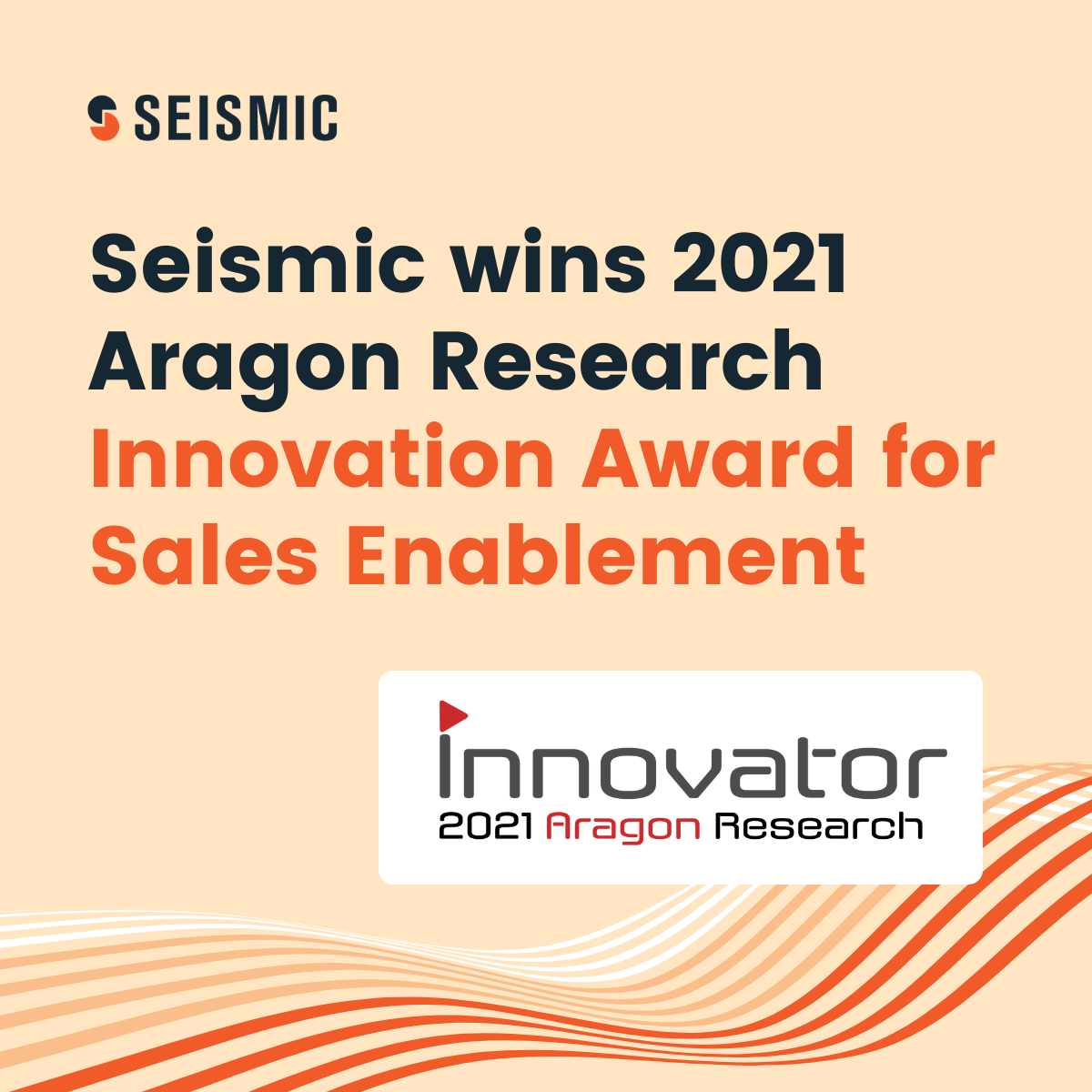Analyst firm Aragon Research recently awarded Seismic the 2021 Innovation Award for Sales Enablement. Seismic’s Heather Cole, VP Market Growth, looks back at the year of innovation and what’s to come in the enablement space in 2022.
At last week’s Aragon Transform, the annual Aragon Research awards ceremony, Seismic was formally presented with the 2021 Innovation Award for Sales Enablement. The award recognizes providers leveraging visionary use of technology to not only adapt as markets change, but to actively disrupt and inform how their markets will evolve. We’re truly grateful to receive this honor for the third consecutive year and we continue to strive to bring new, different, and better capabilities to our customers who constantly inspire us to raise the bar.
To say that definition of sales enablement has evolved over the past year would be an understatement. The acceleration of digital transformation that started in 2020 shifted into a higher gear in 2021. B2B buying and selling have become reliant on digital technologies, and sales enablement software has graduated from a “nice-to-have” part of the tech stack to “must-have” for businesses aiming to keep up with the rapid pace of change. Enablement as a profession has also exploded during this time — over the past several months, employers on LinkedIn posted, on average, 12,000-15,000 enablement roles each month! The need for innovation has never been greater — in how enablement is executed to meet the changing buyer needs, seller demands, and even how and who we hire.
Looking forward to 2022, enablement innovation won’t slow down. Here are three key trends that will define enablement in the coming year:
- The buyers will call the shots on whether or not there is any value to in-person engagement, leading to a heavily digital, but hybrid, model
- The function of enablement is rapidly maturing and its remit continues to grow well beyond enabling only the sales function.
- Customer-facing roles have adapted to the digital environment and are demanding “just in time” enablement
Let’s briefly touch on these three trends below:
Not in MY office
Whether it is the customer who is still working from their home office or the buying organization that is trying to minimize “unnecessary” visitors, in-person sales meetings will not return as the default method of buyer engagement anytime soon, if at all. The pandemic has accelerated a trend that industry researchers have been predicting for years. McKinsey, which has been studying B2B interactions for decades, found that buyers want to choose how they engage. Two out of three buyers now prefer virtual human interactions or digital self-service over in-person engagement. However, that seems to be beneficial to most (83%) B2B selling organizations that overwhelmingly said this new omnichannel approach is as (or more) effective than their previous GTM approach. In 2022, we also expect buyers to become more and more comfortable engaging with a seller over social media and SMS, but only when they see them as a valuable, trustworthy, and responsive resource.
Enablement for all
In Seismic’s Annual Sales Enablement Benchmark Report published earlier this year, we found that visionary companies don’t just focus their enablement efforts on sales teams — more and more, they are extending their enablement program to any role that interacts with the buyer or customer and, of course, the managers of those teams. A Forrester study completed this fall confirmed this trend when its results showed that a whopping 98% of enablement organizations cater their support to roles beyond sales. In 2022, enablement will continue expanding across the entire GTM organization in an effort to provide a consistent client experience through fully enabled teams that have the competence, confidence, content, and context to bring value to every conversation.
The new “lobby learning”
Way back in the days when sellers were always meeting customers in-person (circa 2019), there was a practice known as “lobby learning” or “parking lot prep,” which makes every sales and enablement manager cringe just a little. It was the habit of doing last-minute prep right before a meeting at the customer site. With the shift to virtual human interactions, the new “lobby learning” is all digital, often AI-driven, and very effective when executed properly. It is also what some of the best sellers now demand — give me what I need when I need it to have a better conversation with my buyer! Today’s seller is no longer the sole “teller” of information. They’re more of a sherpa, guiding and educating their buyer throughout the purchase decision. This includes the ability to quickly pivot and source information and content in real-time as they are preparing and executing customer conversations.
According to McKinsey, buyers want to interact with a sales rep much more when researching a new product or service, but if they’re purchasing the exact same product or service, they’re 50% less likely to desire interaction with a salesperson. The buyers and customers have also increased their expectations — if they are going to actually talk to a seller, that person better bring greater value than what they can get through self-service. AI-guided selling tools and real-time learning can help ensure that sellers are set up for success, equipping them with the content they need in the moment, to better address the requirements of any customer interaction.
Looking for other key trends and insights from the Seismic team? Check out these recent blog posts:
- How buyer behavior has evolved and what it means for sales
- How forward-looking organizations get enablement right
The identification of an Aragon Research award winner is not an endorsement by Aragon Research of any vendor, product, or service.
